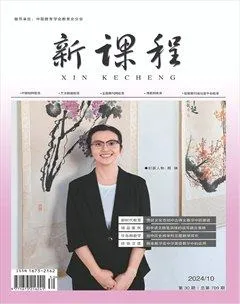基于核心素养视域的初中英语体验式教学设计
本文以人教版八年级上册Unit 1 Where did you go on vacation?Section A教学为例,探讨核心素养视域下的初中英语体验式教学。
一、教学内容分析
“Where did you go on vacation?”是人教版英语“Go for it!”八年级上册第一单元的内容,以“度假经历”为核心话题,围绕假期活动展开,讨论“过去做过的事情”。在语法方面,涉及一般过去时态的一般疑问句“Did you ...?”及一般过去时态的特殊疑问句“Where/How/What ...?”主要是让学生学会用一般过去时态询问和描述过去发生的事件。在词汇方面,涉及度假相关的地点名词(museum,Central Park等)、描述性形容词(fantastic,awful,unfriendly等)。
二、学情分析
学生在之前的学习中接触了一些谈论经历的英语知识,已经掌握了一般现在时的陈述句和疑问句用法。而对一般过去时,学生也有一定的了解,但是还未深入理解其意义和功能,因此在对话中难以熟练运用。
三、教学目标
1.语言能力:掌握与度假相关的英语词汇,能准确地运用一般过去时的一般疑问句“Did you go/see/buy ...?”和一般过去时的特殊疑问句“Where/How/What ...?”询问和讨论去过哪里、做过什么事情。掌握复合不定代词的应用,包括something,anything,some-one,anyone等。
2.文化意识:通过对假期经历的分享和讨论,感受不同地区的人文特色和文化差异;形成热爱大自然的意识,以自身行动保护大自然。
3.思维品质:通过对度假经历的描述和交流,培养逻辑思维,并能够合理组织语言,清晰表达自己的观点。
4.学习能力:能够正确运用一般过去时态描述假期发生的事情;掌握旅游日记的写作方法;培养良好的学习习惯和积极的学习态度。
四、教学重难点
教学重点:与度假相关的词汇(museum,central,fantastic,awful,unfriendly等);用一般过去时询问假期活动(Where/How/What ...?Did you go/see/buy ...?等)及其回答(I went to ...Yes,I did./No,I didn’t.等)。
教学难点:Where引导的特殊疑问句及其回答,区分一般过去时和一般现在时在语境中的正确运用;不定代词的用法。
五、教学方法
本课主要采用体验式教学法,将学生带入“分享假期经历”的情境中,让学生分享自己的度假经历,带动学生的情感体验,并促使学生主动参与到英语交流过程中。
六、教学过程
(一)情境导入,激活学生学习思维
1.利用多媒体创设情境,引入话题
师:Hello,classmates,look.(利用多媒体展示一些旅行的图片、视频等)
师:These places are really beautiful. Students,let’s share your summer vacation activities. Where did you go on vacation?
(教师鼓励学生积极举手发言,并在学生发言过程中给予肯定和鼓励,对表达不准确的地方,适当给予引导,增强学生的口语表达能力。)
(学生被多媒体展示的旅行图片、视频吸引,在教师的引导下,积极回忆自己的度假经历。)
生(预设):I went to the mountain,and the scenery was beautiful.
生(预设):I went to the museum with my parents.
2.学生主动分享度假感受
师:It’s really good. It seems that everyone’s holiday activities are wonderful. I can’t wait to learn more. Who would like to share your feelings during the holiday?
(指名回答)
师:It seems that you really want to share your experience on the mountain with everyone. What did you see on the mountain?
生(预设):I saw beautiful scenery on the mountain, but some people littered the rubbish. I think we should protect the environment.
生(预设):The air on the mountain is very fresh, with tall trees,green grass and colorful flowers. I feel very happy.
(设计意图:利用多媒体展示吸引人的旅行图片和视频,迅速抓住学生的注意力,营造积极、愉快的学习氛围。)
(二)贴近生活,提高学生的语言能力
1.引导学生观察插图,学习词汇
师:The partners in the textbook also went on vacation. Guess where did they went? Fill in the blanks according to the illustrations.
(引导学生观察课本中的插图,并与插图下方的词汇一一对应)
师:From the picture,who went to the mountain?Where did A go?Why does F look unhappy?
(打乱顺序进行提问,引导学生结合自己的填空进行回答)
(学生按照教师的提示观察插图,并将a~g填写到下方对应的横线处。如:went to the mountain c ,went to the beach a )
(结合自己的答案回答教师提出的问题)
生(预设):C went to the mountain.
生(预设):A went to the beach.
生(预设):Everyone else went out on a trip,and f stayed at home,so she was unhappy.
2.进行角色扮演对话,巩固理解
师:Helen traveled to a great place. Do you know where did he go?
(引导学生观察2d部分的插图)
师:Yes,it’s a waterfall from the picture. This waterfall is very famous. It’s called Huangguoshu Wat-erfall.
(多媒体设备播放黄果树瀑布的视频)
师:How do you feel when you see Huangguoshu Waterfall?
师:Helen must be very shocked to see Huang-guoshu Waterfall with his own eyes. Let’s see what he shared with his friends.
(引导学生两两一组,分别扮演Helen和Rick,阅读2d部分的对话)
(学生在教师的引导下观察2d部分的图片)
生(预设):Waterfall./Helen went to see the wat-erfall.
(学生观看多媒体播放的视频,并分享自己的观看感受)
生(预设):Huangguoshu Waterfall is very big.
生(预设):Very spectacular.
生(预设):Like a river from the sky.
(学生两两一组,扮演Helen和Rick进行对话,进一步巩固所学的词汇和语法。)
(设计意图:利用贴近生活的话题引导学生观察插图,获取信息,在图文结合中加深对词汇的理解和把握。)
(三)生生互动,培养学生的学习能力
1.用学到的词汇和句式编写对话
师:我们在本节课学习了一般过去时态的用法,现在请结合你自己的旅行经历,模仿Helen和Rick的对话创编一段对话。
学生两两一组编写对话,分享自己的旅行经历。
案例(预设):
生A:Hi,B,how was your summer vacation?
生B:Very happy,I went on holiday with my family.
生A:Where did you go?Was it fun?
生B:Yes,we went to Beijing together.
生A:Wow,did you climb the Great Wall?
生B:Yes,climbing the Great Wall was very tiring,but it is also very happy. We also took many photos.What about you?Did you go on holiday?Is there any-thing interesting?
生A:I didn’t go on holiday. It was too hot,but pai-nting at home was also very interesting.
2.组内交流假期活动,并记录在表格中
师:It seems that everyone’s holiday is wonderful. Let’s communicate with our classmates and then fill in the form in 3c.
……
师:Have you filled it out?Let’s share,what did everyone do in your group?
师:What didn’t everyone do?
师:What did some students do and some students didn’t do?
学生4~6人一组,一起查看表格中的信息,并按照实际情况填写。
生(预设):Everyone in our group ate something in the restaurant.
生(预设):No one in our group bought anything.
生(预设):A and B went to visit their families,but C and D didn’t.
(设计意图:小组活动是体验式教学的重要环节,通过生生互动的过程,引导学生将所学的词汇、语法知识迁移到对话过程中,并通过读写结合,发展学生的语言综合能力,正确运用一般过去时态描述已经发生过的事情。)
(四)知识拓展,增强学生的文化意识
1.结合自己的假期活动,尝试撰写旅行日记
教师展示一篇简单的旅行日记,向学生介绍旅行日记的格式和包含的要素,如日期、地点、天气、活动、感受等。
师:Now,please try to write a travel diary about your last vacation. You can use the words and sentences we learned before.
(学生根据教师的指导和范例,撰写自己的旅行日记。)
(在学生写作过程中,教师巡视,提供必要的帮助和指导。)
2.分享度假中需要注意的事项
师:As we all know,we need to pay attention to many things during our vacation. Can you share with us your experience?
(教师引导学生以小组为单位进行讨论,并在各小组间巡视,参与讨论,鼓励学生积极发言,同时给予适当的提示和建议。)
(学生在小组内分享自己的想法和经验,可以是一些针对所见所闻的感想,也可以是从书中或长辈处得来的经验。)
生A(预设):It is easy to fall down and get hurt when climbing mountains,so be sure to pay attention to safety.
生B(预设):Don’t litter,it will destroy the envir-onment.
(讨论结束后,每个小组选一名代表,将自己组的想法分享给大家,其他组补充。)
(设计意图:通过让学生撰写旅行日记和分享度假注意事项,旨在拓展学生的语言运用能力和文化意识。)
通过各种体验式的教学活动,学生不仅提升了语言能力,还培养了思维品质和文化意识,提升了学习能力,为核心素养的发展提供了支持。
(作者单位:乌鲁木齐八一中学)
编辑:常超波

